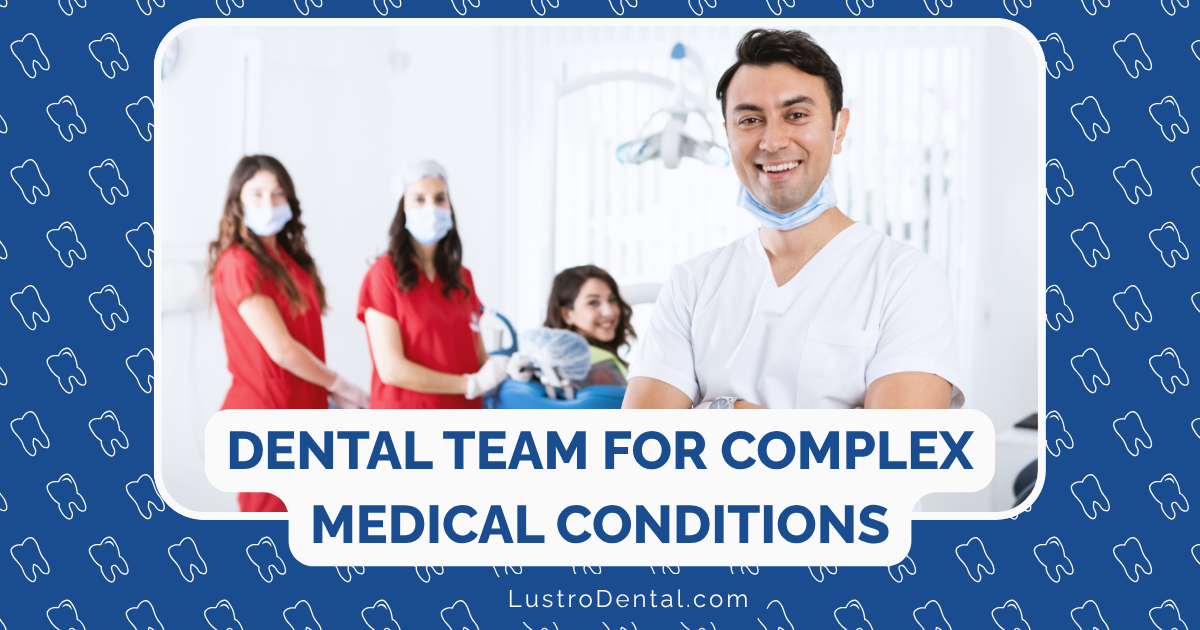Building Trust Over Time: The Importance of Consistency for Special Needs Patients

For many of us, a dental appointment is a minor inconvenience—perhaps slightly uncomfortable, but manageable. For individuals with special needs, however, the unfamiliar sounds, sensations, and procedures of a dental visit can trigger profound anxiety or even fear. This is where consistency becomes not just helpful, but essential.
Throughout my years advocating for improved dental care, I’ve witnessed remarkable transformations when practices prioritize consistency for their special needs patients. What begins as an impossible challenge often evolves into a manageable—sometimes even positive—experience through the power of familiarity and trust built over time.
Understanding the Trust Challenge in Special Needs Dentistry
Before exploring solutions, let’s understand why building trust is particularly crucial for special needs patients.
The Trust Barrier
Patients with special needs—whether developmental, cognitive, physical, or sensory—often face unique challenges in dental settings:
- Sensory processing differences: Heightened sensitivity to lights, sounds, smells, and touch
- Communication barriers: Difficulty expressing discomfort, asking questions, or understanding instructions
- Anxiety and fear: Elevated stress responses to unfamiliar situations
- Past negative experiences: Previous traumatic healthcare encounters that color expectations
- Difficulty with change: Challenges adapting to new environments, people, or routines
Research published in the Journal of Dentistry confirms what many practitioners observe: trust in the dentist-patient relationship directly correlates with patient pain perception and anxiety levels. For special needs patients, this connection is even more pronounced.
Dr. Maria Chen, who specializes in treating patients with intellectual and developmental disabilities, explains: “Trust isn’t just about feeling comfortable—it’s about creating a foundation where treatment becomes possible at all. Without trust, we often can’t even begin.”
The Cost of Inconsistency
When special needs patients encounter inconsistency in their dental care, the consequences can be significant:
- Treatment avoidance: Refusing necessary dental care due to anxiety
- Deteriorating oral health: Increased risk of serious dental problems requiring more invasive treatment
- Traumatic experiences: Negative associations that make future care more difficult
- Regression in progress: Loss of hard-won comfort and cooperation
- Caregiver stress: Added burden on families managing difficult dental experiences
A systematic review of barriers to dental care for children with disabilities found that negative experiences and lack of consistent, specialized care significantly contributed to poor oral health outcomes. The good news? Consistency offers a powerful solution.
The Pillars of Consistency in Special Needs Dental Care
Creating consistency involves multiple elements working together to build familiarity and predictability.
1. Consistency in Personnel
Perhaps the single most important factor in building trust is maintaining consistency in who provides care.
Research-Backed Benefits: A study published in BMC Oral Health found that caregivers consistently identified familiar staff as a critical factor in successful dental visits for special needs patients. The relationship with specific providers—not just the practice as a whole—was key to reducing anxiety and improving cooperation.
Practical Implementation:
- Dedicated provider teams: Assign the same dentist, hygienist, and assistant to special needs patients whenever possible
- Introductions to backup staff: Familiarize patients with alternative providers who may step in if regular staff are unavailable
- Staff photos: Provide visual reminders of who patients will see at their next visit
- Minimized turnover: When hiring for positions that interact with special needs patients, emphasize the importance of long-term commitment
Dr. James Wilson, whose practice specializes in treating patients with autism, shares: “We’ve seen patients who couldn’t tolerate even basic exams transform into cooperative patients simply because they saw the same hygienist at every visit for a year. That relationship is irreplaceable.”
2. Environmental Consistency
The physical environment plays a crucial role in creating comfort and predictability.
Research-Backed Benefits: Research in Special Care in Dentistry highlights that familiar environments help patients with special needs learn coping skills and reduce anxiety. Consistency in setting creates a foundation for successful treatment.
Practical Implementation:
- Same treatment room: Use the same operatory for each visit when possible
- Consistent setup: Maintain similar equipment arrangement and room organization
- Visual consistency: Keep decor, colors, and visual elements stable
- Sensory consistency: Maintain similar lighting, sounds, and temperature
- Waiting area familiarity: Create a consistent pre-appointment experience
“We always use Room 3 for Alex,” explains dental hygienist Sarah Johnson. “It’s his room. We even keep a small sign with his name that we put up when he arrives. This simple consistency has dramatically reduced his anxiety.”
3. Procedural Consistency
How appointments unfold—the sequence of events, the language used, the techniques employed—should follow predictable patterns.
Research-Backed Benefits: The American Academy of Pediatric Dentistry emphasizes that patients learn best when messages and expectations are delivered consistently. Procedural consistency helps patients develop familiarity with the rhythm and requirements of dental care.
Practical Implementation:
- Consistent appointment structure: Follow the same sequence of steps at each visit
- Standardized language: Use the same terms, phrases, and instructions
- Consistent time allocation: Schedule appointments at similar times of day
- Predictable transitions: Maintain the same approach to moving between procedures
- Consistent sensory experiences: Use the same prophylaxis paste flavor, the same type of suction tip, etc.
Dental assistant Michael Brown notes: “We created a visual schedule for Sophia that shows each step of her cleaning. We follow it exactly the same way every time. After three visits, she started pointing to the next step before we even mentioned it—she had internalized the routine.”
4. Scheduling Consistency
When and how appointments occur significantly impacts the trust-building process.
Research-Backed Benefits: The Oral Health Foundation recommends that patients with special needs have shorter, more frequent appointments rather than lengthy, infrequent visits. This approach builds familiarity and prevents overwhelming experiences.
Practical Implementation:
- Regular intervals: Maintain consistent timing between appointments
- Same day/time when possible: Schedule visits on the same day of week and time of day
- Consistent duration: Keep appointments to a predictable length
- Arrival and departure routines: Create consistent check-in and check-out experiences
- Advance preparation: Provide the same pre-appointment reminders and preparation materials
“Tuesday at 10 am is Jason’s time,” explains office manager Lisa Chen. “We’ve blocked that slot for him every three months. The predictability helps him prepare mentally, and we’ve seen his anxiety decrease with each consistent visit.”
Communication Strategies That Build Trust Over Time
Consistency in communication is fundamental to developing trust with special needs patients.
Tailored Communication Approaches
Research-Backed Benefits: A study in Special Care in Dentistry found that dental professionals who adapted their communication style to meet the specific needs of special needs patients achieved significantly better outcomes and patient cooperation.
Practical Implementation:
- Consistent communication style: Maintain the same tone, volume, and pace
- Personalized communication tools: Use the same visual supports, social stories, or communication boards
- Predictable instructions: Deliver directions in the same way each visit
- Consistent reinforcement: Use the same praise and encouragement strategies
- Familiar explanations: Explain procedures using consistent language and analogies
Documentation for Consistency
Creating and maintaining detailed records ensures consistency across visits and providers.
Practical Implementation:
- Preference profiles: Document specific likes, dislikes, triggers, and successful approaches
- Communication notes: Record effective phrases, words to avoid, and response patterns
- Success strategies: Document techniques that worked well in previous visits
- Progress tracking: Note improvements and challenges to inform future approaches
- Sharing mechanisms: Ensure all team members have access to and review these notes before appointments
Dr. Rebecca Torres emphasizes: “Our detailed special needs profiles have transformed our practice. When a patient arrives, everyone from reception to the dental assistant knows exactly how to interact with them in a consistent way. The continuity has dramatically improved our success rate with complex patients.”
Case Studies: The Power of Consistency in Action
Real-world examples illustrate how consistency transforms dental experiences for special needs patients.
Case Study 1: Michael’s Journey
Patient Profile: Michael, a 12-year-old with autism spectrum disorder and significant sensory sensitivities
Initial Challenge: Unable to tolerate even entering the dental office without extreme distress; had never completed a full examination
Consistency Approach:
- Same dental team for every visit
- Same treatment room with identical setup
- Consistent Tuesday 3:00 pm appointments
- Identical visual schedule and preparation materials
- Consistent desensitization protocol starting with just entering the waiting room
Results After One Year:
- Successfully completed full examination and cleaning
- Reduced anxiety medications from three to one
- Parents report he now reminds them about “Tuesday dentist day”
- Successfully treated two small cavities
- Uses the same visual schedule at home for daily oral hygiene
Michael’s mother shares: “The consistency has been life-changing. What started as our biggest stress is now just a regular part of our routine. The trust he’s built with Dr. Wilson and his team transferred to how he approaches his daily brushing too.”
Case Study 2: Eleanor’s Transformation
Patient Profile: Eleanor, a 67-year-old with early-stage dementia and anxiety disorder
Initial Challenge: Combative during dental procedures; required sedation for basic care; declining oral health
Consistency Approach:
- Same hygienist and dentist for all visits
- Morning appointments only, same day of week
- Identical step-by-step verbal cues
- Consistent familiar music during treatment
- Same family member present for support
Results After Six Months:
- Completed routine cleanings without sedation
- Recognized and greeted dental team members by name
- Demonstrated decreased anxiety markers (blood pressure, heart rate)
- Improved home care compliance
- Successfully received fillings with only local anesthesia
Eleanor’s daughter notes: “The consistency gave my mother something to hold onto as her memory declined. The familiar faces, voices, and routines created an island of comfort in what could have been a frightening experience.”
Practical Implementation for Dental Practices
Creating consistency requires intentional systems and practice-wide commitment.
Staff Training and Protocols
- Cross-training limitations: While cross-training is valuable, limit provider changes for special needs patients
- Communication protocols: Establish standard approaches for different types of special needs
- Documentation requirements: Create thorough systems for recording successful approaches
- Scheduling policies: Implement special scheduling considerations for consistency
- Emergency protocols: Develop plans for maintaining some consistency even in urgent situations
Physical Environment Considerations
- Dedicated spaces: Consider designating specific areas for special needs patients
- Environmental checklists: Create verification systems to ensure consistent setups
- Sensory inventories: Maintain the same sensory tools and supports
- Visual supports library: Develop standardized visual aids for procedures
- Transition spaces: Create consistent areas for arrival adjustment and departure preparation
Practice Management Strategies
- Scheduling systems: Implement software flags or notes for consistent scheduling
- Staff scheduling considerations: Factor special needs appointments into provider scheduling
- Communication systems: Develop methods for sharing consistent information across the team
- Feedback mechanisms: Create ways for patients and caregivers to report on consistency
- Continuous improvement: Regularly review and refine consistency approaches
The Role of Caregivers in Reinforcing Consistency
Caregivers are essential partners in building trust through consistency.
Caregiver Collaboration Strategies
- Home preparation routines: Establish consistent pre-appointment activities
- Communication continuity: Use similar language at home and in the dental office
- Practice reinforcement: Maintain consistent oral hygiene approaches that mirror dental visits
- Positive associations: Create consistent positive connections to dental visits
- Information sharing: Provide updates about changes in needs or successful approaches
Dr. Lisa Zhang emphasizes: “When we align our in-office approach with what caregivers do at home, we see dramatically better results. Consistency across environments is powerful.”
Overcoming Challenges to Consistency
Despite best intentions, maintaining consistency can be challenging. Here are strategies for addressing common obstacles:
Staff Changes
- Transition planning: When staff changes are necessary, implement gradual introductions
- Shadowing opportunities: Have new providers observe sessions before participating
- Detailed handoffs: Ensure comprehensive information transfer about patient preferences
- Familiar elements: Maintain other consistency elements when staff must change
- Honest preparation: Communicate changes in advance with appropriate support
Facility Limitations
- Portable consistency kits: Create mobile sets of familiar items when rooms must change
- Visual preparation: Use photos to prepare patients for necessary environmental changes
- Priority scheduling: Implement systems that prioritize consistency for those who need it most
- Consistent elements: Identify which environmental factors matter most to each patient
- Gradual transitions: When changes are necessary, implement them incrementally when possible
The Future of Consistency in Special Needs Dentistry
As we look toward the future, several promising developments may enhance our ability to provide consistent care:
- Digital consistency tools: Apps and technologies that provide familiar preparation and support
- Virtual reality preparation: Immersive experiences that familiarize patients with procedures
- Telehealth continuity: Remote check-ins that maintain connection between in-person visits
- Specialized training: Increased educational focus on consistency for special needs patients
- Practice certification: Standards and recognition for practices that excel in providing consistent care
Conclusion: Trust as the Foundation for Care
Building trust through consistency isn’t just about making dental visits more comfortable—though that’s certainly important. It’s about creating the foundation that makes comprehensive dental care possible for special needs patients who might otherwise go without essential treatment.
When we prioritize consistency in personnel, environment, procedures, and communication, we transform what could be traumatic experiences into manageable, even positive ones. We open the door to preventive care that can save patients from more invasive treatments later. We demonstrate respect for the unique needs of each individual.
As dental professionals, caregivers, and advocates, our commitment to consistency sends a powerful message: we see you, we value you, and we’ll be here for you—the same faces, the same places, the same approaches—visit after visit. That predictability creates the safety that allows trust to grow and flourish over time.
By embracing consistency as a core value in special needs dentistry, we don’t just improve individual dental visits—we transform the entire healthcare experience for some of our most vulnerable patients. And that’s something worth smiling about.
Have you experienced the power of consistency in dental care for special needs patients? Share your stories and strategies in the comments below.







